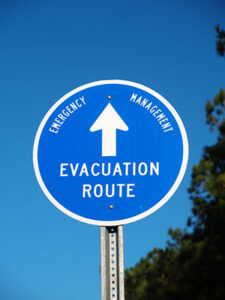Barks Blog
Prepare Clients for Potential Emergencies

Tens of thousands of people have had to evacuate their homes due to the fires. Over the summer, thousands more in Texas, Florida, and the Caribbean evacuated due to hurricanes.
What happens to all of those people’s pets?
Here during the most intensive fire activity, two local organizations helped with pet and livestock evacuations. The county animal control office commandeered barn and stall space at the fairgrounds for horses, cattle, sheep, goats, and chickens. The shelter also accepted some chickens, other small animals, and of course, dogs and cats. The regional SPCA took in pets as well. Both organizations also maintained lists of local families willing to foster animals. This could mean taking in a dog or two — or offering pasture space for horses.
During the hurricanes, shelters all over the country pitched in to help transport pets to safer areas. In California, Bay Area organizations are doing the same.
How can we, as dog professionals, help?
One way is to join volunteer rescue and foster operations; those who cannot offer temporary homes can offer supplies or transportation.
In the longer term, we can make emergency preparation part of our training classes and advice given to new puppy owners or adopters at shelters and rescue organizations. One post I saw during the fires solicited advice on moving cats. Responses ranged from pillowcases to zip-tying laundry baskets together. Creativity abounds, but panicked pet owners shouldn’t be desperately seeking ideas as flames are racing toward their homes.
Teach pet-owners what to do well ahead of an emergency.Educate pet owners on ways to transport pets. Emphasize how vital it is to crate-train dogs and cats and to have travel crates available. Hand out a checklist of supplies to pack in an emergency bag.
Most areas now include pets in disaster planning. Find out whether your locale would have pet-friendly shelters or separate evacuation shelters for pets. If your city doesn’t have an adequate plan, maybe you can get other pet professionals, including shelter workers, together to help put together a better plan.
Do you have the ability to foster evacuated pets? Maybe you can help a local organization start a list of local people who can help out in emergencies.
After Hurricane Katrina, many organizations put together plans and advice for people with pets, and the latest string of disasters is a reminder to update our plans. Here are some resources that can help you get started:
From CDC: Disaster Preparedness for Your Pet
From HSUS: Make a Disaster Plan for Your Pets

